Bactericidal Properties of Rod-, Peanut-, and Star-Shaped Gold Nanoparticles Coated with Ceragenin CSA-131 against Multidrug-Resistant Bacterial Strains
- PMID: 33809901
- PMCID: PMC8004255
- DOI: 10.3390/pharmaceutics13030425
Bactericidal Properties of Rod-, Peanut-, and Star-Shaped Gold Nanoparticles Coated with Ceragenin CSA-131 against Multidrug-Resistant Bacterial Strains
Erratum in
-
Correction: Bucki et al. Bactericidal Properties of Rod-, Peanut-, and Star-Shaped Gold Nanoparticles Coated with Ceragenin CSA-131 against Multidrug-Resistant Bacterial Strains. Pharmaceutics 2021, 13, 425.Pharmaceutics. 2024 Oct 24;16(11):1354. doi: 10.3390/pharmaceutics16111354. Pharmaceutics. 2024. PMID: 39598609 Free PMC article.
Abstract
Background: The ever-growing number of infections caused by multidrug-resistant (MDR) bacterial strains requires an increased effort to develop new antibiotics. Herein, we demonstrate that a new class of gold nanoparticles (Au NPs), defined by shape and conjugated with ceragenin CSA-131 (cationic steroid antimicrobial), display strong bactericidal activity against intractable superbugs.
Methods: For the purpose of research, we developed nanosystems with rod- (AuR NPs@CSA-131), peanut-(AuP NPs@CSA-131) and star-shaped (AuS NPs@CSA-131) metal cores. Those nanosystems were evaluated against bacterial strains representing various groups of MDR (multidrug-resistant) Gram-positive (MRSA, MRSE, and MLSb) and Gram-negative (ESBL, AmpC, and CR) pathogens. Assessment of MICs (minimum inhibitory concentrations)/MBCs (minimum bactericidal concentrations) and killing assays were performed as a measure of their antibacterial activity. In addition to a comprehensive analysis of bacterial responses involving the generation of ROS (reactive oxygen species), plasma membrane permeabilization and depolarization, as well as the release of protein content, were performed to investigate the molecular mechanisms of action of the nanosystems. Finally, their hemocompatibility was assessed by a hemolysis assay.
Results: All of the tested nanosystems exerted potent bactericidal activity in a manner resulting in the generation of ROS, followed by damage of the bacterial membranes and the leakage of intracellular content. Notably, the killing action occurred with all of the bacterial strains evaluated, including those known to be drug resistant, and at concentrations that did not impact the growth of host cells.
Conclusions: Conjugation of CSA-131 with Au NPs by covalent bond between the COOH group from MHDA and NH3 from CSA-131 potentiates the antimicrobial activity of this ceragenin if compared to its action alone. Results validate the development of AuR NPs@CSA-131, AuP NPs@CSA-131, and AuS NPs@CSA-131 as potential novel nanoantibiotics that might effectively eradicate MDR bacteria.
Keywords: Au NPs; CSA-131; MDR (multidrug-resistant); ceragenins; nanosystems.
Conflict of interest statement
The authors declare no conflict of interest.
Figures
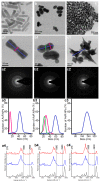

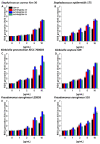

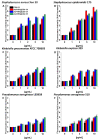

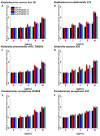
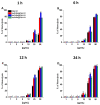

Similar articles
-
Ceragenins and Ceragenin-Based Core-Shell Nanosystems as New Antibacterial Agents against Gram-Negative Rods Causing Nosocomial Infections.Pathogens. 2023 Nov 13;12(11):1346. doi: 10.3390/pathogens12111346. Pathogens. 2023. PMID: 38003809 Free PMC article. Review.
-
Ceragenin-Coated Non-Spherical Gold Nanoparticles as Novel Candidacidal Agents.Pharmaceutics. 2021 Nov 16;13(11):1940. doi: 10.3390/pharmaceutics13111940. Pharmaceutics. 2021. PMID: 34834355 Free PMC article.
-
Gold Nanoparticles Functionalized With 5-Amino-2-Mercaptobenzimidazole: A Promising Antimicrobial Strategy Against Carbapenem-Resistant Gram-Negative Bacteria.Int J Nanomedicine. 2025 Feb 27;20:2485-2504. doi: 10.2147/IJN.S502139. eCollection 2025. Int J Nanomedicine. 2025. PMID: 40034218 Free PMC article.
-
Peanut-Shaped Gold Nanoparticles with Shells of Ceragenin CSA-131 Display the Ability to Inhibit Ovarian Cancer Growth In Vitro and in a Tumor Xenograft Model.Cancers (Basel). 2021 Oct 29;13(21):5424. doi: 10.3390/cancers13215424. Cancers (Basel). 2021. PMID: 34771587 Free PMC article.
-
A Comprehensive Review of Silver and Gold Nanoparticles as Effective Antibacterial Agents.Pharmaceuticals (Basel). 2024 Aug 29;17(9):1134. doi: 10.3390/ph17091134. Pharmaceuticals (Basel). 2024. PMID: 39338299 Free PMC article. Review.
Cited by
-
N-Acetyl-Cysteine Increases Activity of Peanut-Shaped Gold Nanoparticles Against Biofilms Formed by Clinical Strains of Pseudomonas aeruginosa Isolated from Sputum of Cystic Fibrosis Patients.Infect Drug Resist. 2022 Mar 5;15:851-871. doi: 10.2147/IDR.S348357. eCollection 2022. Infect Drug Resist. 2022. PMID: 35281576 Free PMC article.
-
Metallic Nanosystems in the Development of Antimicrobial Strategies with High Antimicrobial Activity and High Biocompatibility.Int J Mol Sci. 2023 Jan 20;24(3):2104. doi: 10.3390/ijms24032104. Int J Mol Sci. 2023. PMID: 36768426 Free PMC article. Review.
-
Bactericidal Activity of Ceragenin in Combination with Ceftazidime, Levofloxacin, Co-Trimoxazole, and Colistin against the Opportunistic Pathogen Stenotrophomonas maltophilia.Pathogens. 2022 May 26;11(6):621. doi: 10.3390/pathogens11060621. Pathogens. 2022. PMID: 35745475 Free PMC article.
-
Ceragenins and Ceragenin-Based Core-Shell Nanosystems as New Antibacterial Agents against Gram-Negative Rods Causing Nosocomial Infections.Pathogens. 2023 Nov 13;12(11):1346. doi: 10.3390/pathogens12111346. Pathogens. 2023. PMID: 38003809 Free PMC article. Review.
-
Targeting the Gut Microbiota to Relieve the Symptoms of Irritable Bowel Syndrome.Pathogens. 2021 Nov 25;10(12):1545. doi: 10.3390/pathogens10121545. Pathogens. 2021. PMID: 34959500 Free PMC article. Review.
References
-
- New Report Calls for Urgent Action to Avert Antimicrobial Resistance Crisis. [(accessed on 4 March 2021)]; Available online: https://www.who.int/news-room/detail/29-04-2019-new-report-calls-for-urg....
-
- Biggest Threats and Data, 2019 AR Threats Report. [(accessed on 27 July 2020)];2019 Available online: https://www.cdc.gov/drugresistance/biggest-threats.html.
Grants and funding
LinkOut - more resources
Full Text Sources
Other Literature Sources
Molecular Biology Databases

